Imaginative Climbing Roses Ideas to Enchant Your Garden
A living waterfall of flowers is a real possibility in your garden. It can spill over your front door. It can cascade down a plain brick wall. A simple fence can become a tapestry of color and scent. You can create this magic. Climbing roses are your paintbrush. And your garden is the canvas. These are not just plants. They are living sculptures waiting to be shaped. Forget boring backyards. We are going to make something enchanting.
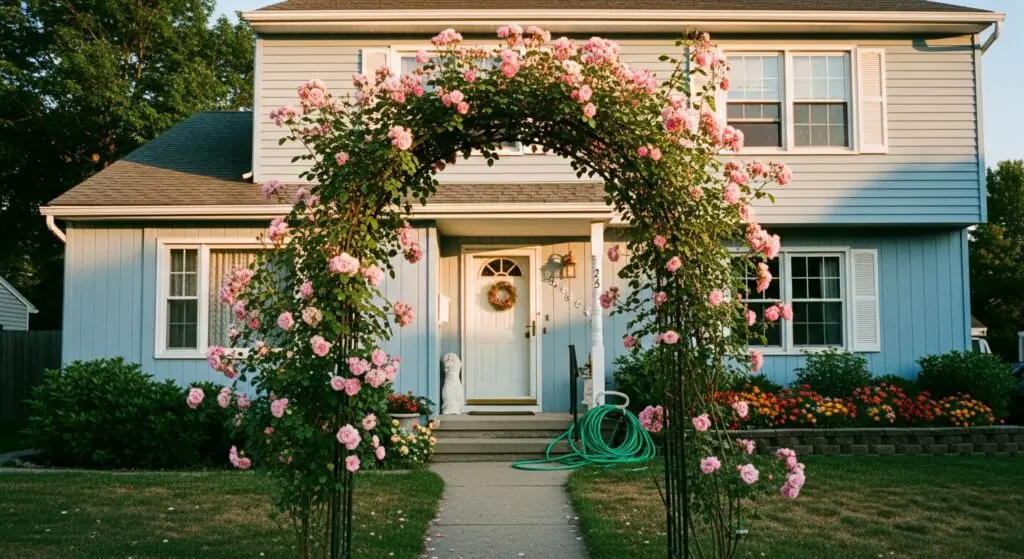
What Are Climbing Roses?
So, what exactly are climbing roses? They are not vines. They don’t have tendrils or suckers to grip onto surfaces. Instead, they produce long, flexible stems called canes. You are the one who trains them. You guide these canes up walls, over arches, and along fences. It is a partnership between you and the plant.
A regular shrub rose grows into a bushy shape all on its own. It is content to stay put. But a climbing rose wants to reach for the sky. Its long canes are an invitation to be creative. Some popular names you might hear are ‘Eden Rose’ or the tough ‘New Dawn’. We will look at more of them later. For now, just know their main trait is their ambition to grow tall.
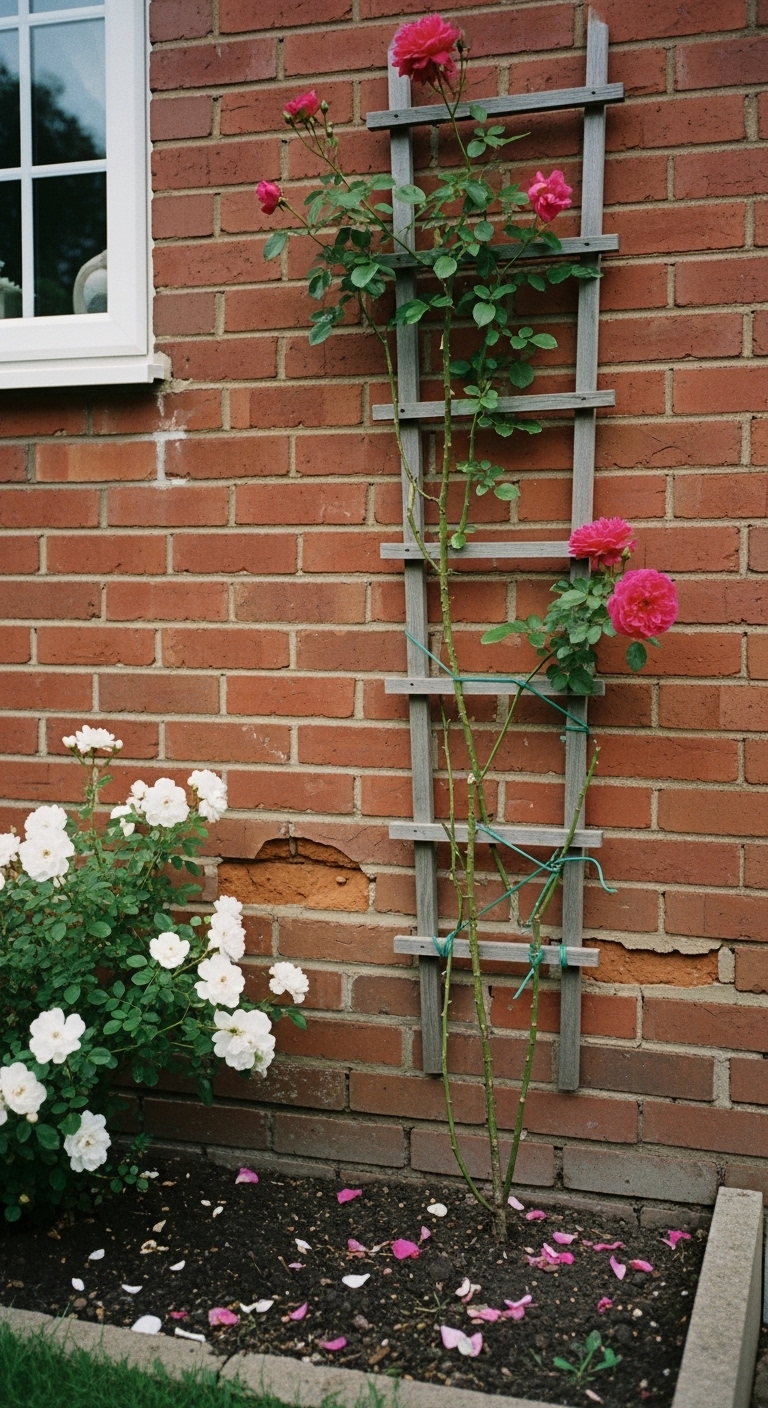
Why Choose Climbing Roses?
Why are gardeners so obsessed with these plants? The answer is simple. Beauty and versatility. A climbing rose can turn the most boring structure into a stunning feature. Have a plain shed wall? Cover it in flowers. Need some privacy on your balcony? Let a rose create a living screen. They bring vertical interest to any garden. Your eyes are drawn upward, making a small space feel larger and a large space more grand.
But it is more than just looks. There is an emotional connection. The scent of a rose can bring back memories. The act of tending to the plant—tying up its canes and watching it grow—is rewarding. They offer practical benefits too. They can provide shade in the summer. And they can increase your home’s curb appeal. A home framed by roses feels welcoming. It feels loved.
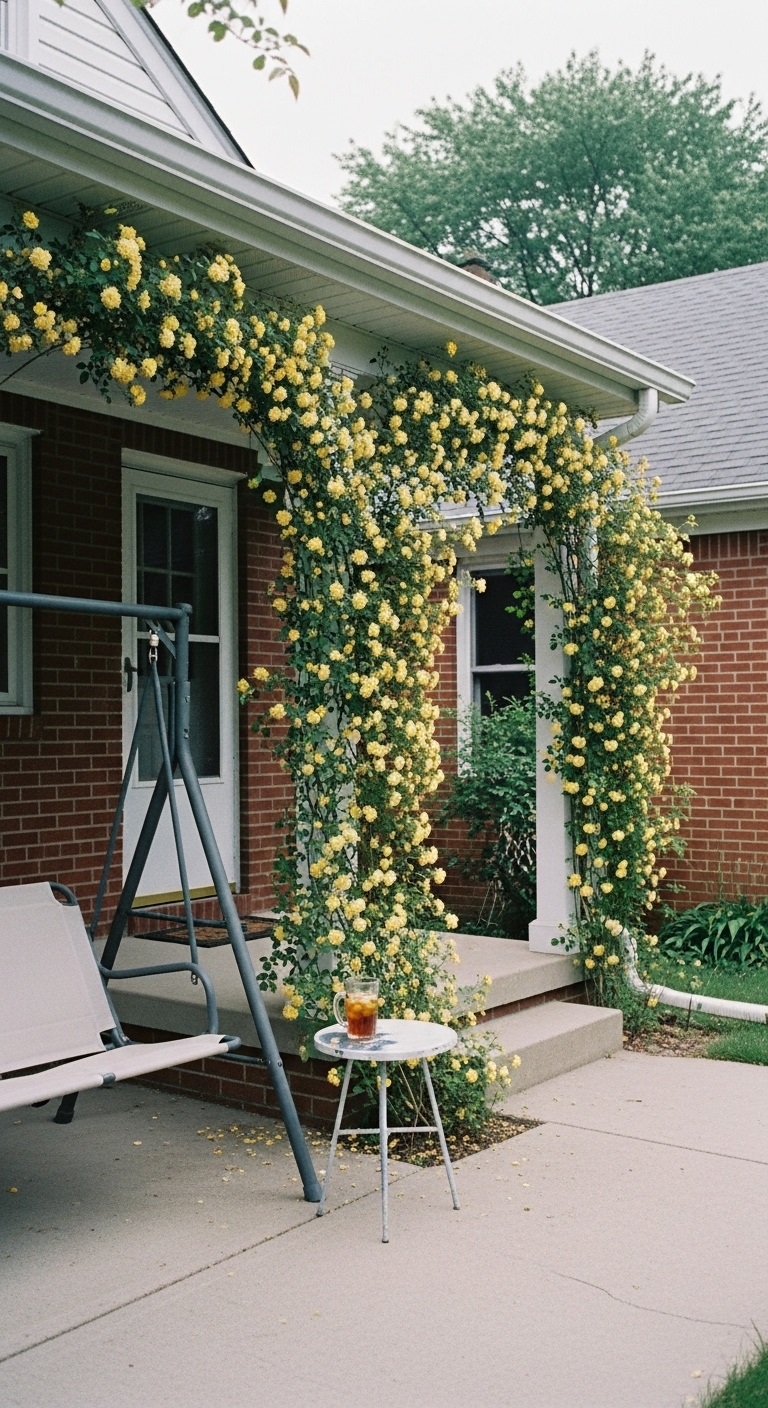
Best Varieties of Climbing Roses
Choosing the right rose is like casting the lead actor for your garden’s play. Each one has its own personality. Some are romantic and full. Others are tough and reliable. Finding the perfect match for your space and climate is key to a beautiful performance that lasts for years.
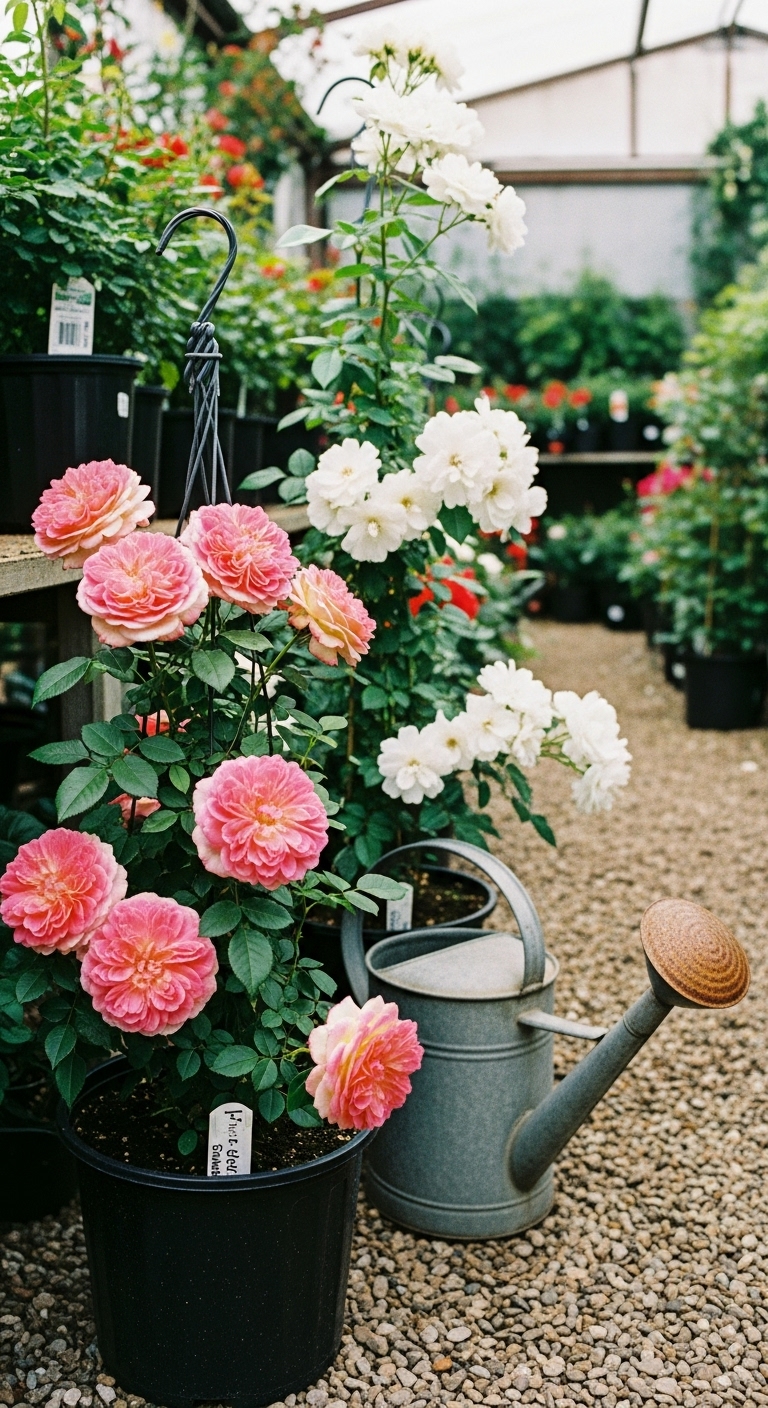
Here are a few popular varieties to get you started:
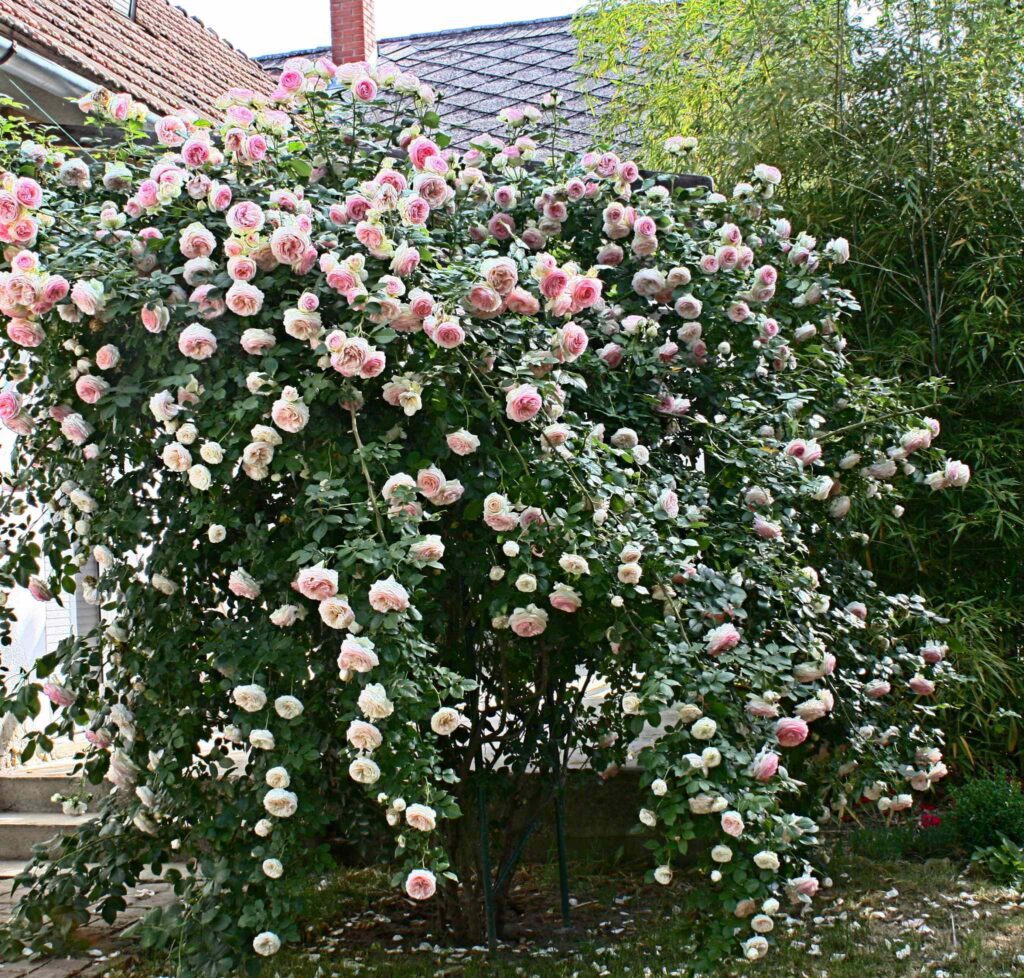
Eden Rose: Also known as ‘Pierre de Ronsard’. This is the rose of fairy tales. Its blooms are large and cup-shaped, packed with petals. They are creamy white on the outside and a beautiful deep pink in the center. A very romantic choice.
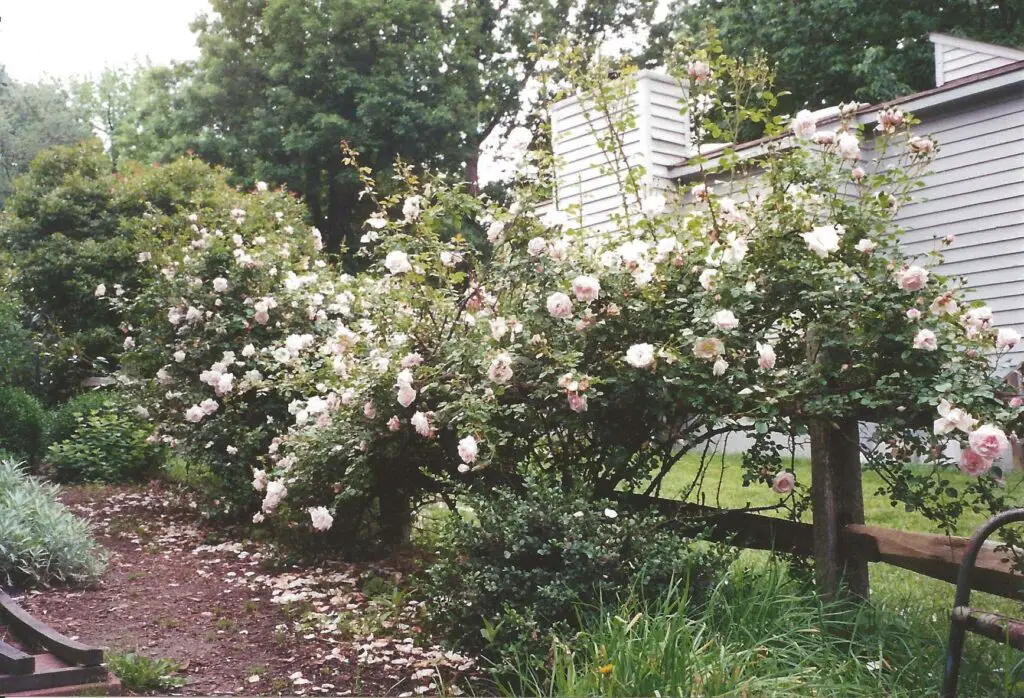
New Dawn: A true classic for a reason. New Dawn produces lovely, pale pink flowers all season long. It is incredibly hardy and disease-resistant. A great option for beginners who want a low-fuss plant with a big reward.
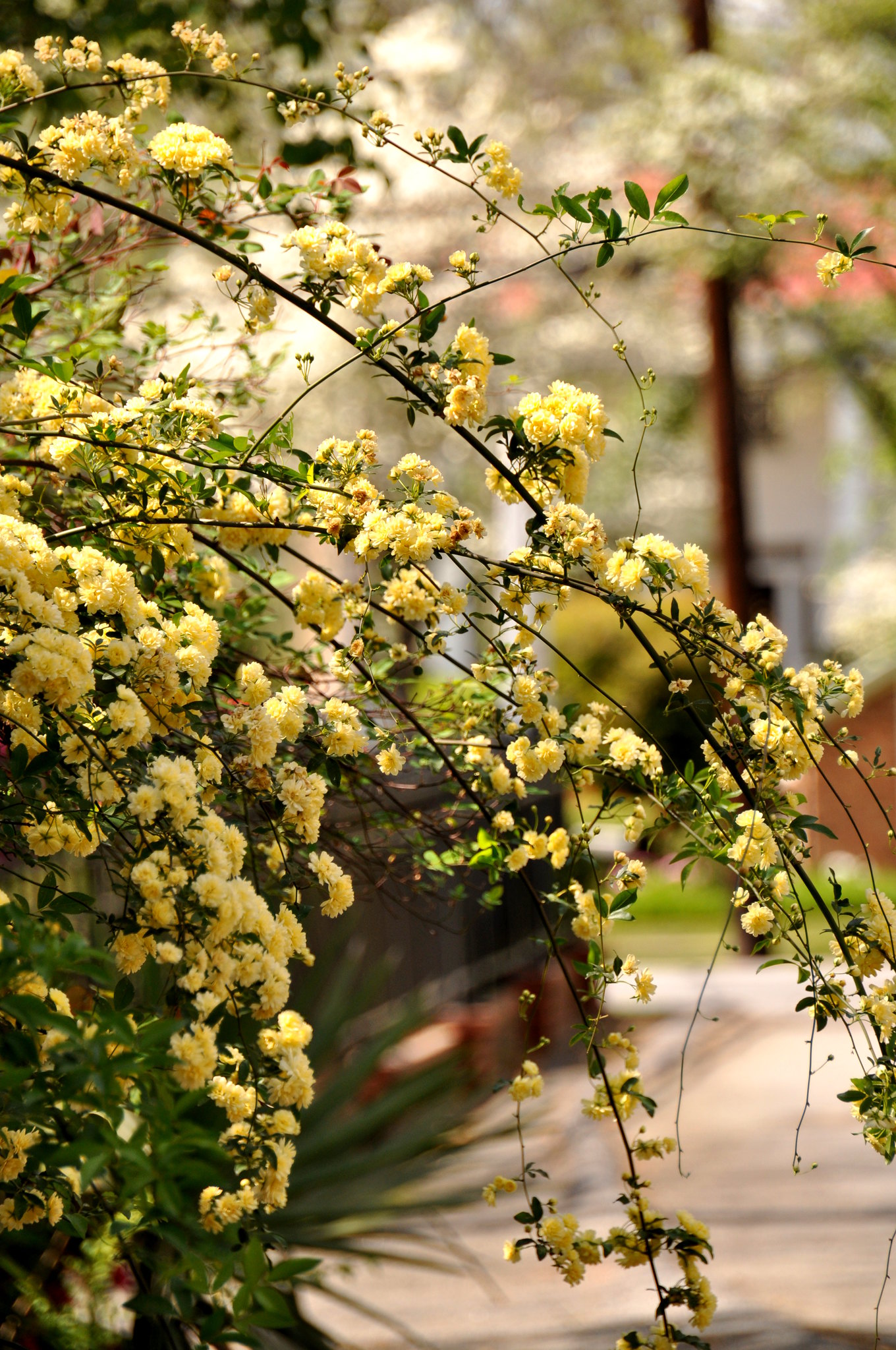
Lady Banks: Want roses without the ouch? Lady Banks’ Rose is almost entirely thornless. It explodes in a massive display of small white or yellow blossoms in the spring. It grows fast and can cover a large area quickly.
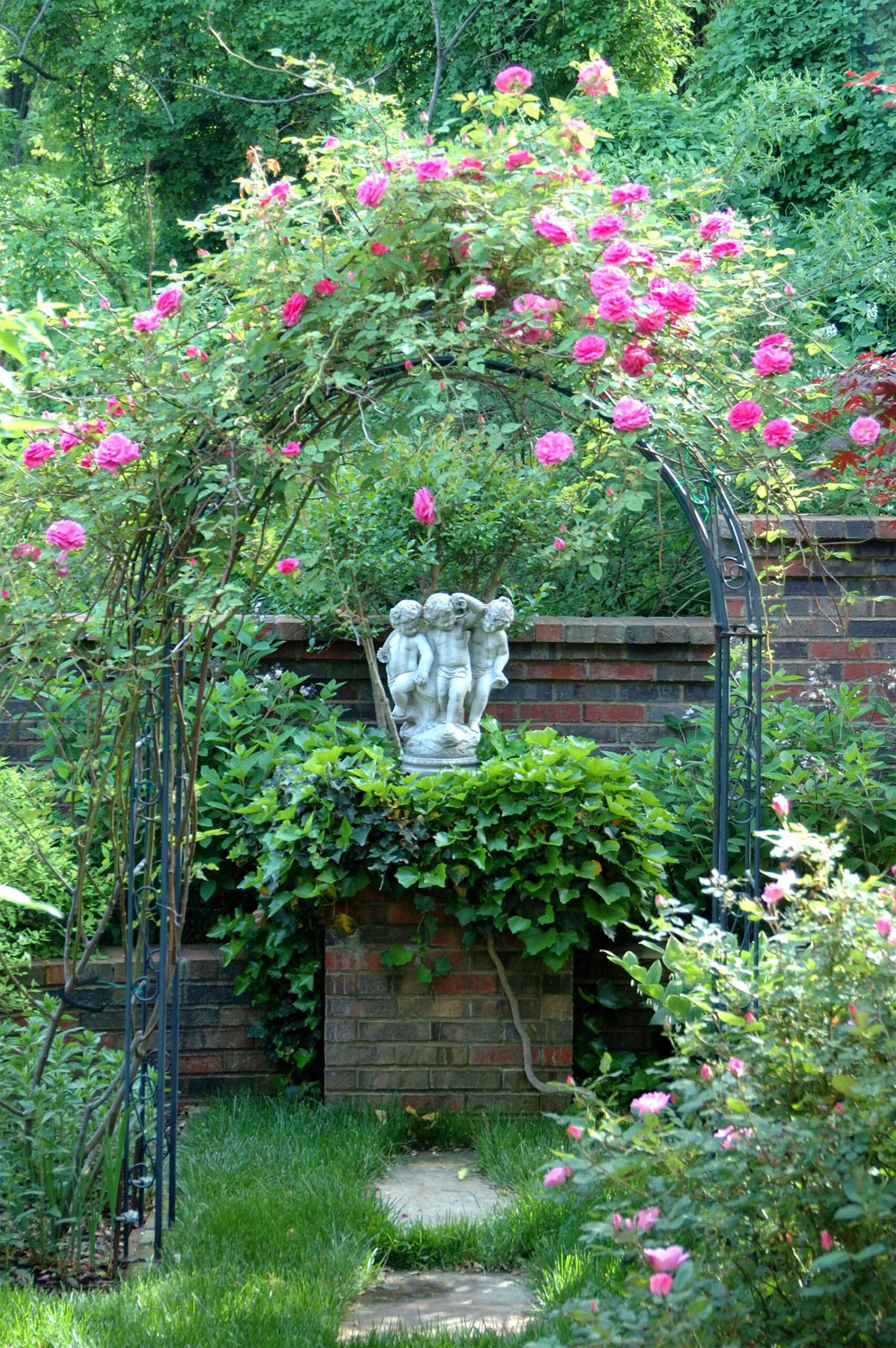
Zephirine Drouhin: Another thornless wonder. Zephirine Drouhin offers deep, cerise-pink flowers that are incredibly fragrant. And it performs better in shady spots than many other roses. A perfect choice for a north-facing wall.
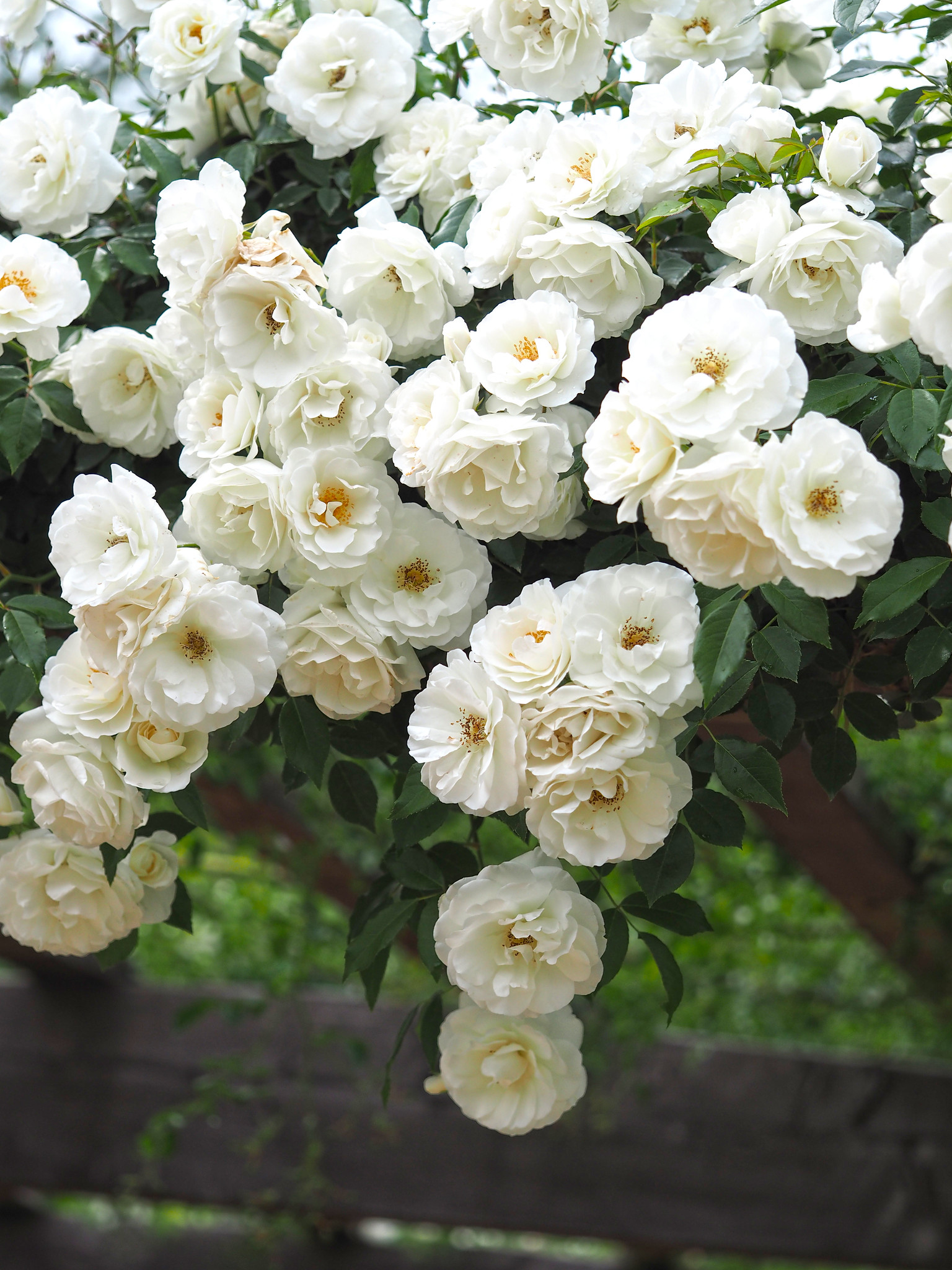
Iceberg: If you want a reliable bloomer, Iceberg is your rose. It produces clusters of brilliant white flowers repeatedly. The climbing version is vigorous and will quickly cover a trellis or fence with clean, bright blooms.
When you select your rose, think about your climate. Consider how much sun the spot gets. Do you want a big burst of flowers once a year, or continuous blooms all summer? Is fragrance important to you? Answering these questions will guide you to your perfect climbing companion.
Creative Ideas for Climbing Roses
Now for the fun part. Let’s dream up some beautiful ways to use these amazing plants. You don’t need a huge estate or a professional landscaper. All you need is a wall, a fence, or even just a pot. And a little bit of imagination. We will turn ordinary garden spots into breathtaking features.
Rose-Wrapped Window Frame
Frame a window with living color. Training a climbing rose around a window creates a soft, romantic vignette. It looks like something straight out of a storybook. Every glance outside becomes a treat. The flowers will draw bees and butterflies, adding life and movement to the view.
For a classic cottage look on a brick or stone house, choose a rose like ‘Eden Rose’. Its heavy, old-fashioned blooms look stunning against rustic textures. Just be sure to install a sturdy wire or trellis system around the window frame first. You will need something to tie the canes to as they grow.
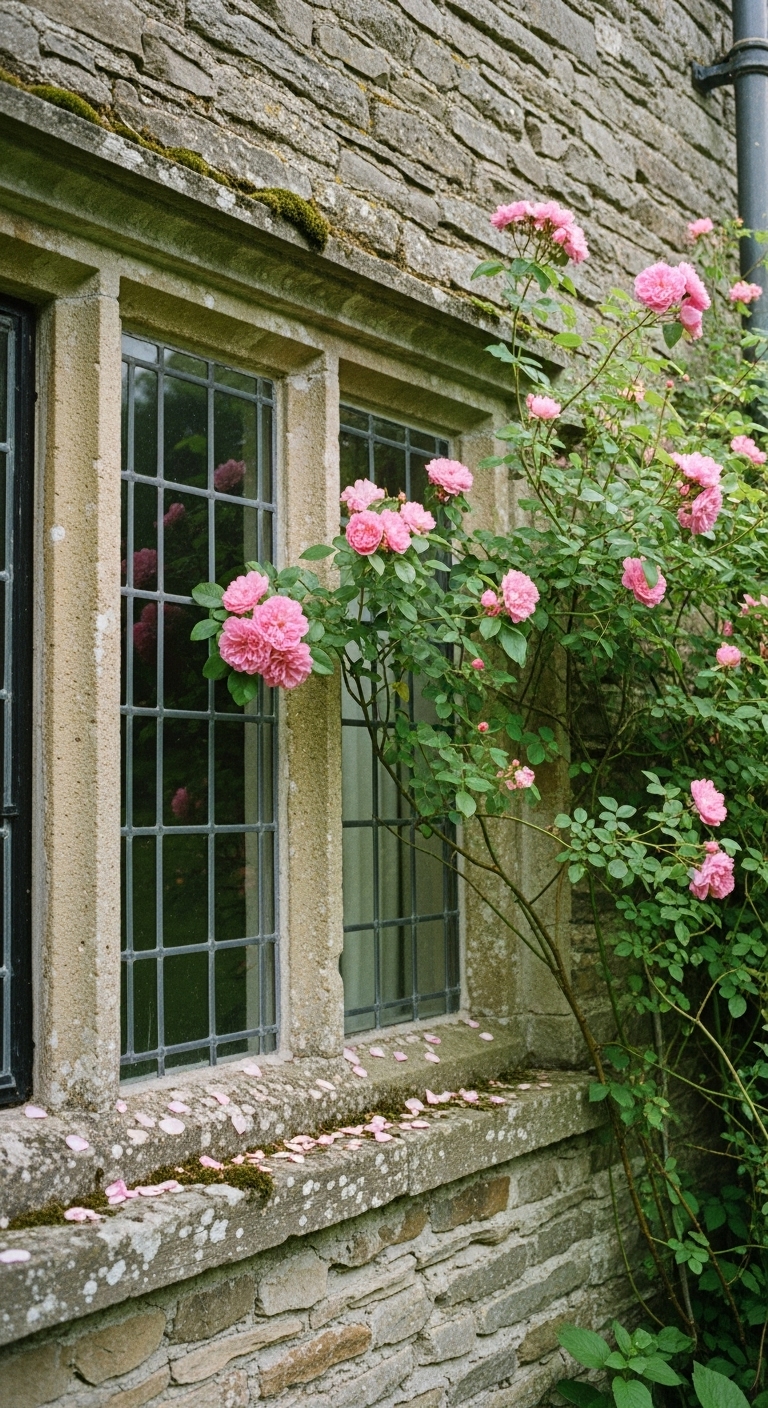
Vertical Rose Columns
Think beyond flat walls and fences. A vertical column wrapped in roses adds elegance and a sculptural element to your garden. You can use a simple wooden post, a metal obelisk, or even a repurposed pillar. A single rose column can be a focal point in a flower bed. Or you can place several in a row to line a path. It’s a modern twist on a classic garden structure.
To create one, set your post or obelisk firmly in the ground. Plant your climbing rose at the base. As the canes grow, gently spiral them around the structure, tying them in place with soft garden twine. A variety with flexible canes like ‘New Dawn’ is perfect for this. Regular pruning will keep it looking neat.
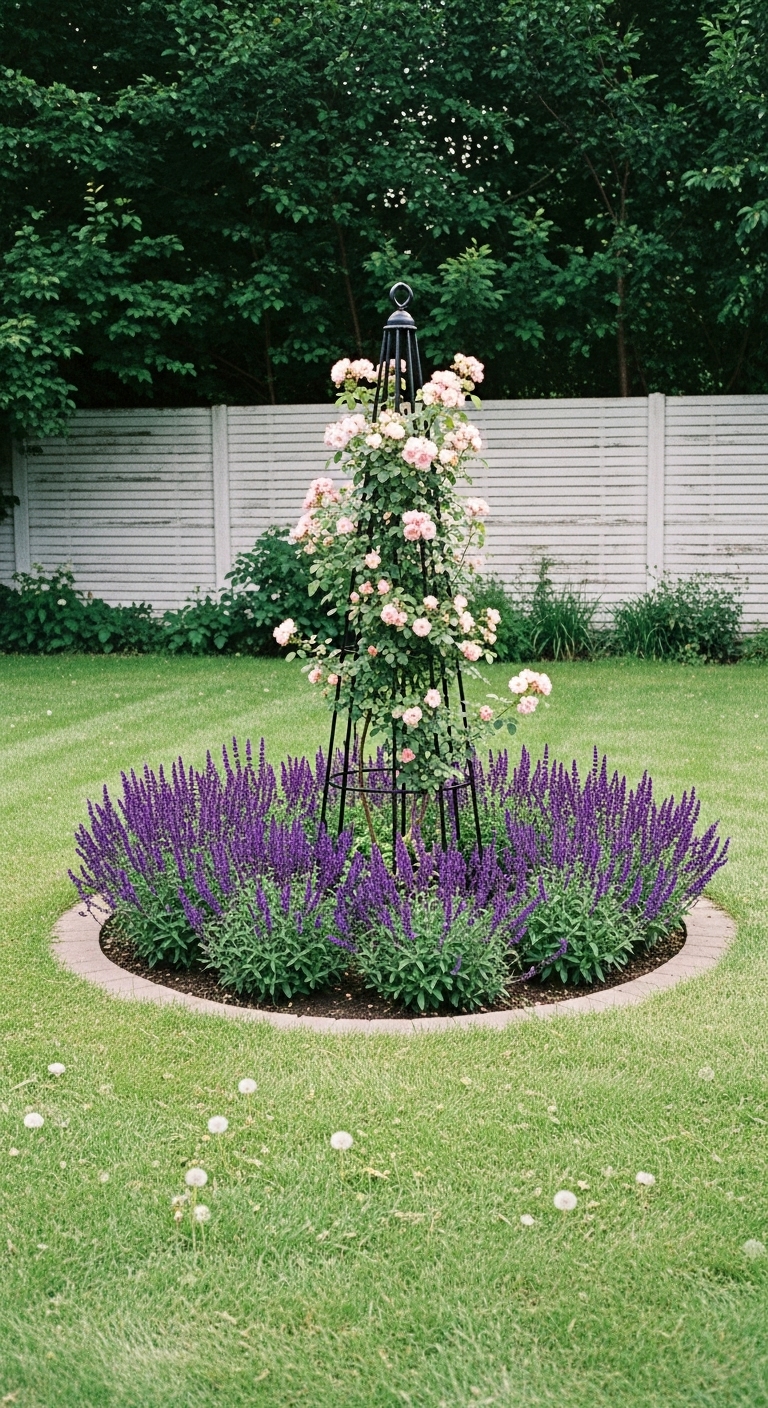
Climbing Rose Curtain for Balconies
Don’t have a big yard? No problem. You can grow a stunning climbing rose on a balcony or small patio. It can create a beautiful living curtain. The curtain provides privacy from neighbors. And it filters the harsh afternoon sun. It turns a small outdoor space into a secret garden hideaway.
You will need a large, deep planter to give the roots enough room. A rectangular trough works well. Install a trellis against the wall or railing. Choose a less vigorous climber that won’t overwhelm the space. The fragrant ‘Zephirine Drouhin’ is a great choice, especially if your balcony is a bit shady.
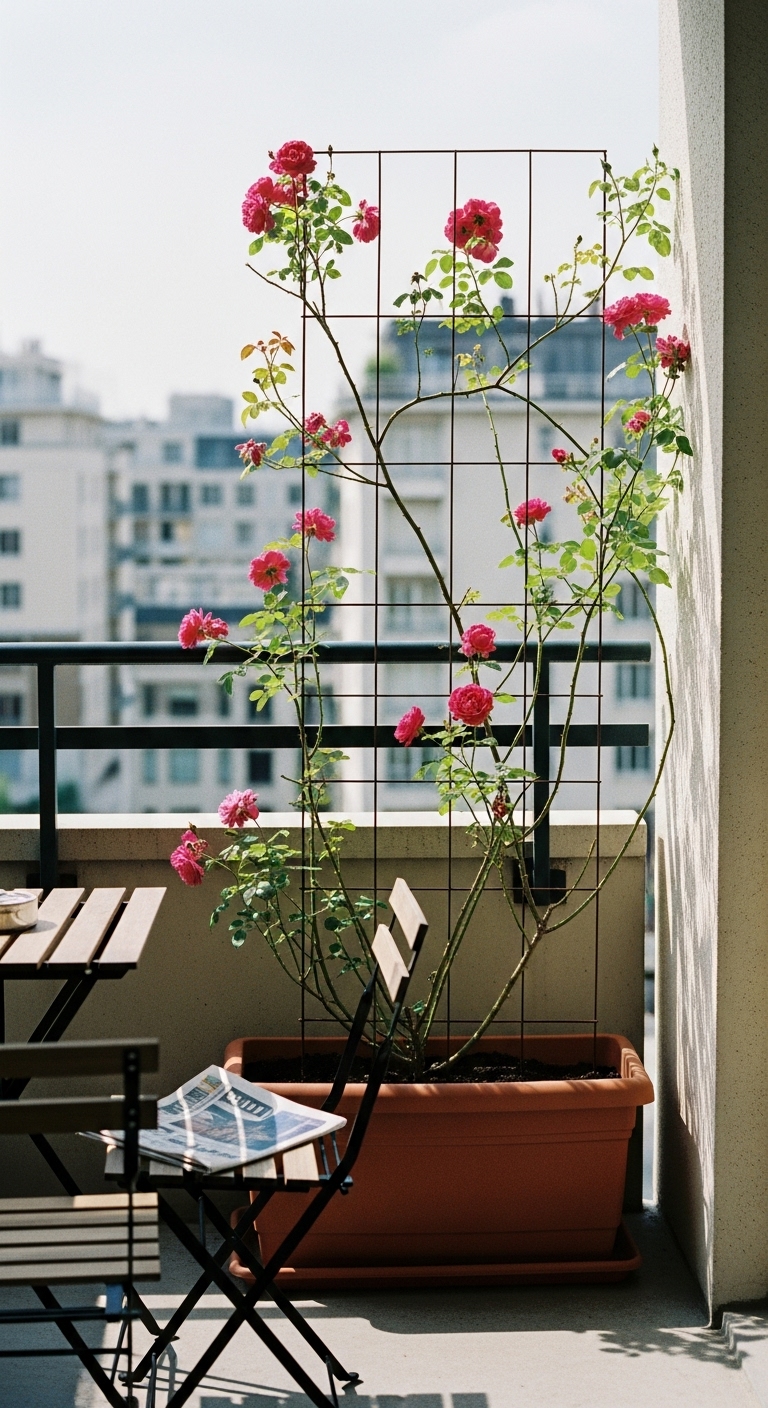
Rose-Framed Front Door
Make an unforgettable first impression. Framing your front door with climbing roses creates a warm and inviting entrance. It says “welcome” better than any doormat. This design boosts your home’s curb appeal instantly. It adds a layer of charm and personality that sets your house apart from the rest on the street.
Choose a rose that blooms repeatedly so your entrance looks great all season. A reliable bloomer like the white ‘Climbing Iceberg’ is an excellent option. It provides a constant show and its neutral color complements any door color. Install a sturdy arch or a trellis on either side of the door to support the plant’s growth.
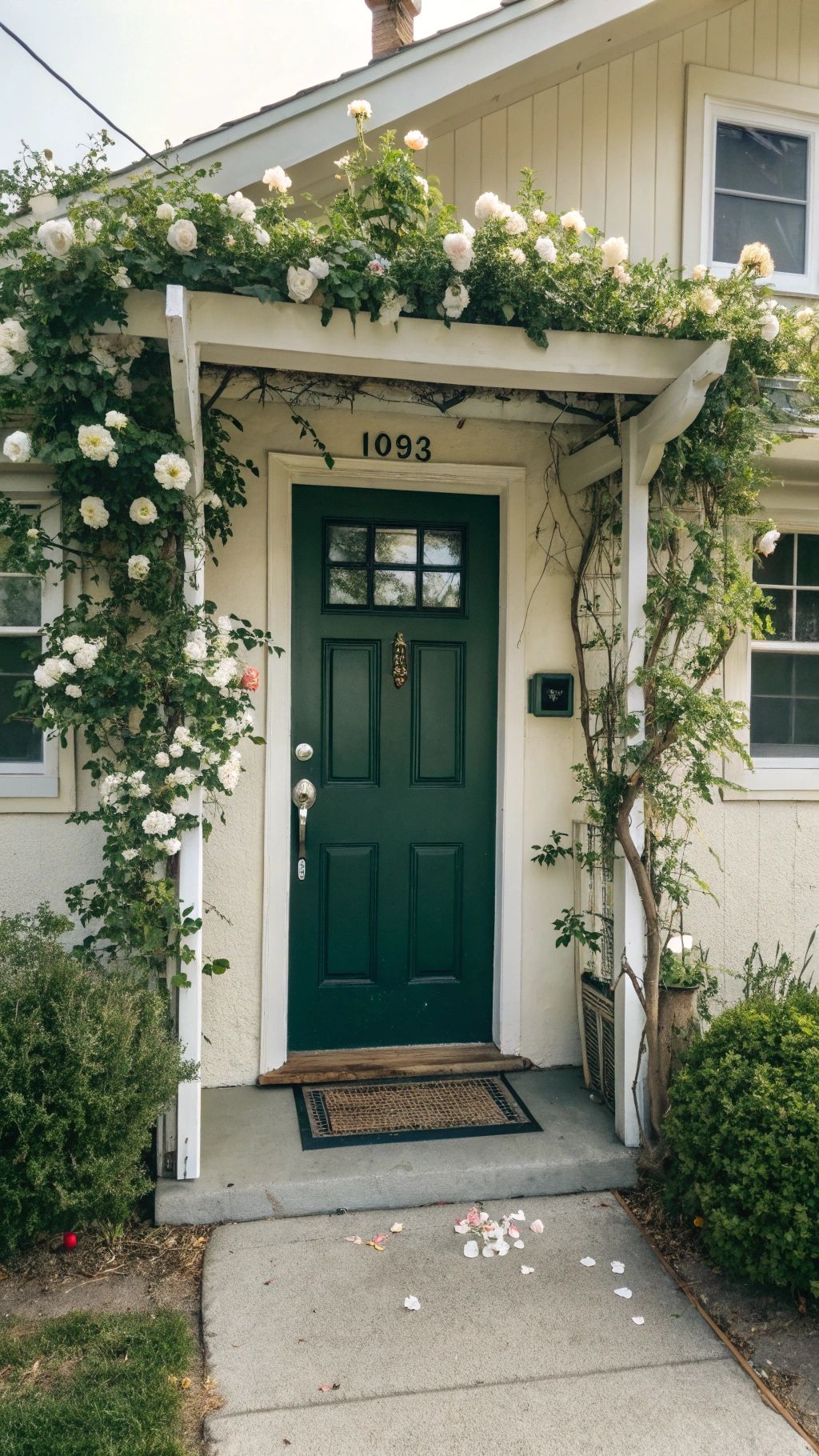
Geometric Trellis Panels
Combine traditional plants with modern style. A geometric trellis is a fantastic way to do this. Think squares, diamonds, or honeycomb shapes instead of a traditional grid. The clean lines of the trellis contrast beautifully with the soft, organic form of the roses. It’s a design that feels both structured and wild.
You can buy pre-made panels or build your own. These panels can be mounted on a wall. Or they can stand alone as a garden screen. For a contemporary look, pair a dark-colored metal trellis with a simple, single-color rose. The deep red of ‘Blaze Improved’ would create a dramatic effect against a black or gray geometric support.

6. Tiered Potted Rose Arbor
Create an arbor effect without digging a single hole. A tiered potted rose arbor is a brilliant solution for patios or decks. It’s also great for renters who can’t make permanent changes. The idea is to arrange several large pots in an arch or entryway shape. You can use pots of varying heights to add more interest. Then, you train smaller climbing roses up and over simple supports placed in each pot.
You can use individual obelisks in each pot. Or you can connect them with flexible wire to form an arch. Choose a compact climbing rose variety that won’t get too big for its container. Something like ‘Starlet Rose Lola’ would be a good fit. This design is a wonderfully space-efficient way to get a grand look.
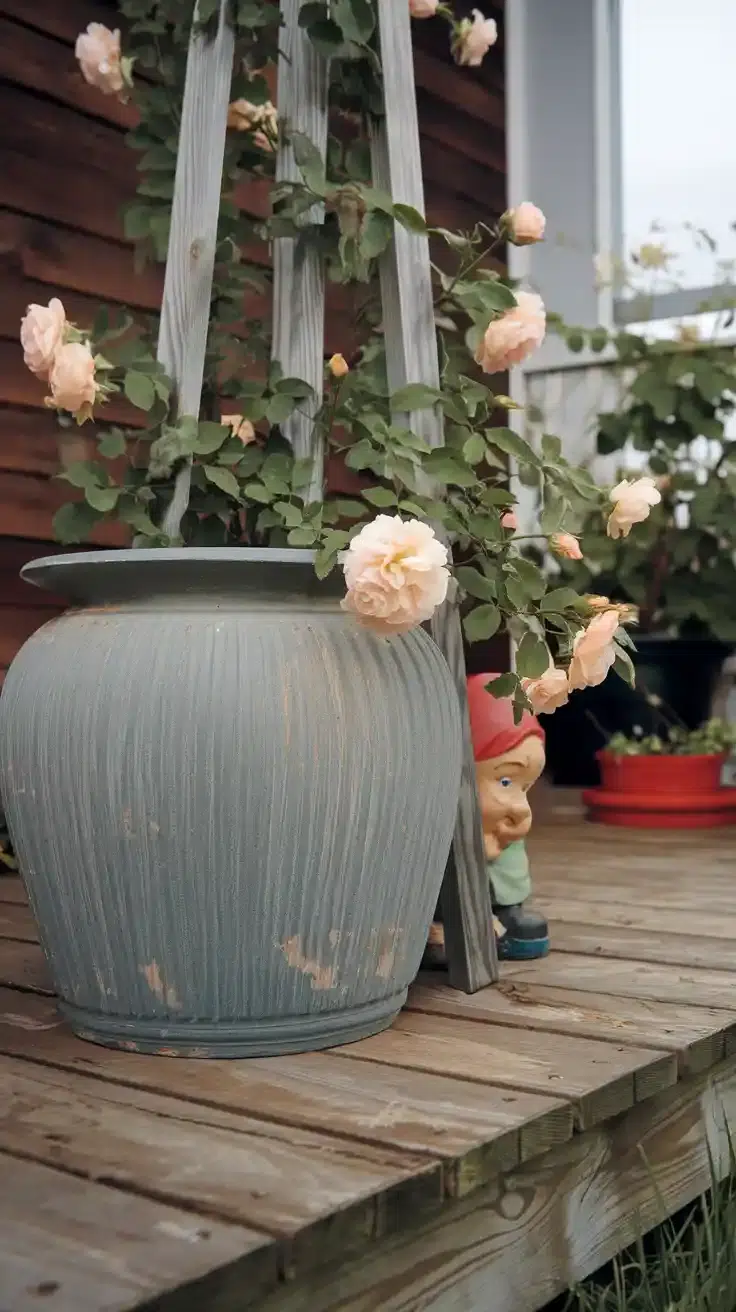
7. Diagonal Rose Trellising on Pergolas
Give your pergola a dynamic and lush appearance. Train your roses on a diagonal instead of straight up the posts. Diagonal trellising creates a sweeping, layered look. It makes the structure feel more integrated with the garden. The angled canes encourage more side shoots. And more side shoots mean more flowers.
To achieve this, install guide wires on your pergola posts at a 45-degree angle. As the main canes of your rose grow, gently tie them to these wires. You can train multiple roses to cross over each other, creating a woven pattern of stems and blooms. A vigorous climber like ‘Lady Banks’ Rose’ can cover a pergola with this technique in just a few seasons.
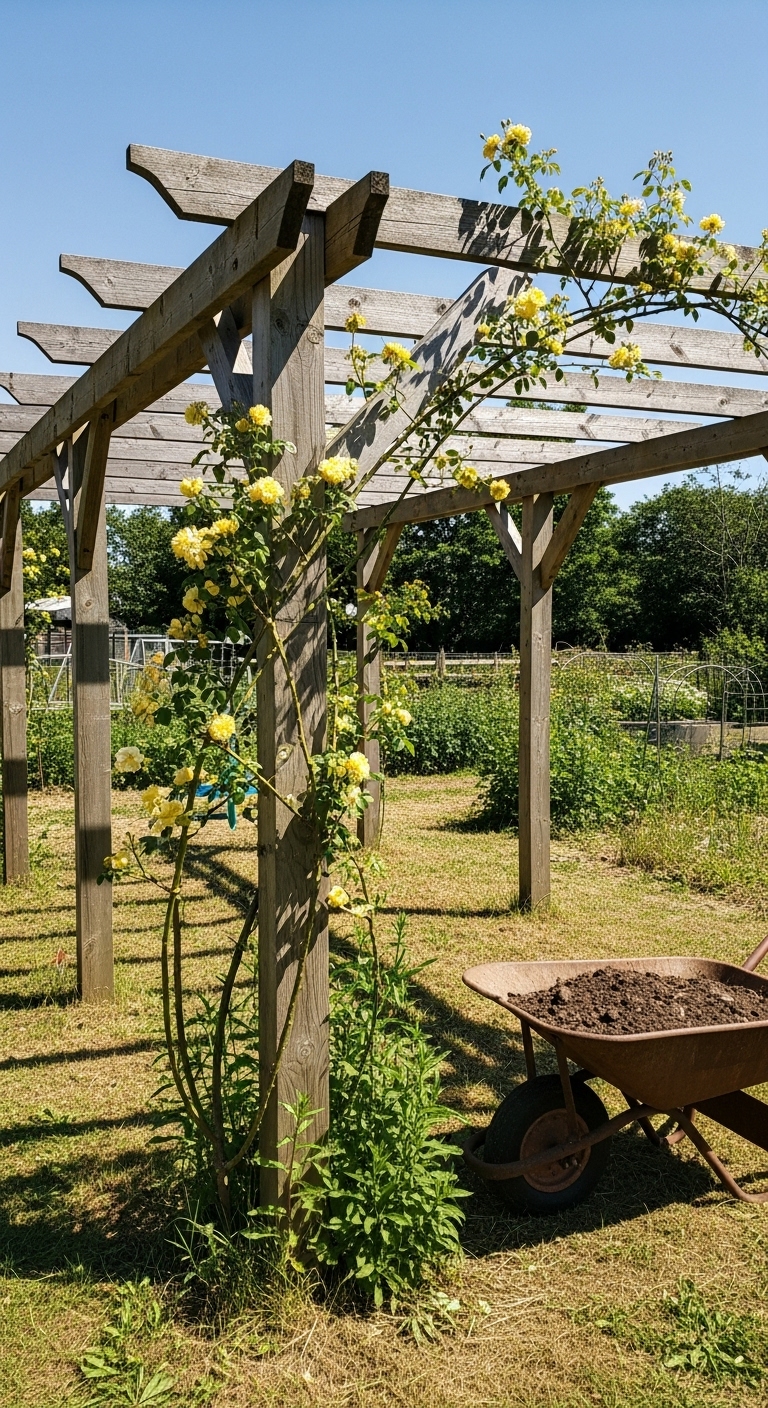
8. Rose Accented Brick Wall Nooks
Turn an architectural quirk into a standout feature. Many homes have small alcoves or brick wall nooks that can feel awkward. Don’t ignore them. Use a climbing rose to turn that space into a deliberate, beautiful moment. A single, well-placed rose can soften the hard lines of brickwork. It draws the eye and adds a pop of color and texture.
The key is contrast. For a dark red brick wall, a pale rose like the creamy yellow ‘Graham Thomas’ would be stunning. For lighter-colored brick, a deep pink like ‘Zephirine Drouhin’ provides a beautiful counterpoint. Simply install a small trellis or a few strands of wire within the nook to give the rose a place to climb.
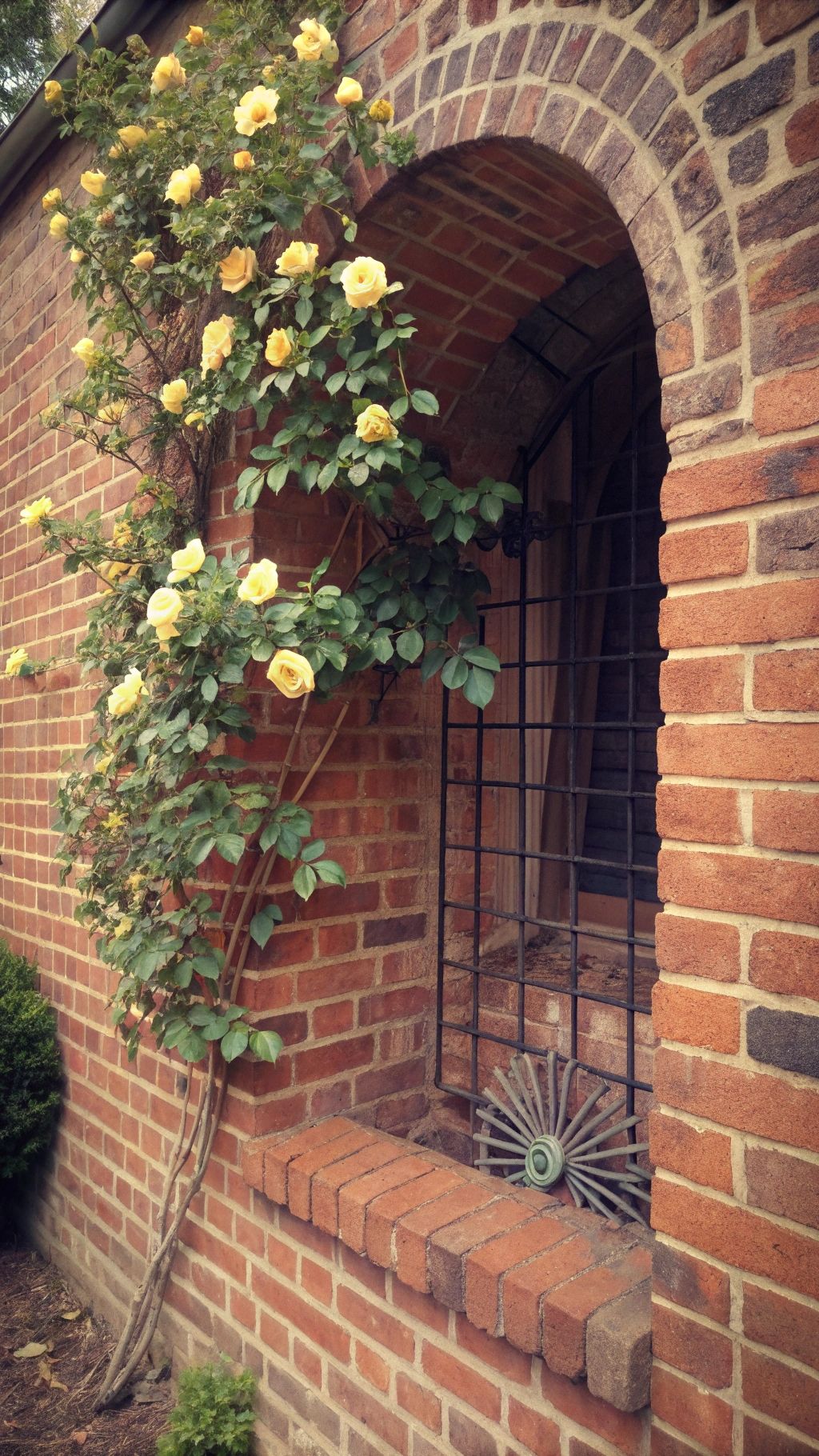
9. Cascading Fence-top Roses
Let your roses flow. Instead of forcing them to grow upright, let them spill over the top of a fence. Cascading roses create a soft, romantic border. They can hide a plain or ugly fence. They also add a layer of privacy and beauty to your yard’s perimeter. This method looks especially lovely on a simple wooden or chain-link fence.
Choose a variety with long, arching canes that have a natural weeping habit. ‘New Dawn’ and ‘Albéric Barbier’ are excellent choices for this. Plant the rose at the base of the fence. Train the main canes up to the top. Then, just let the new growth arch up and cascade down the other side. The effect is a waterfall of flowers.
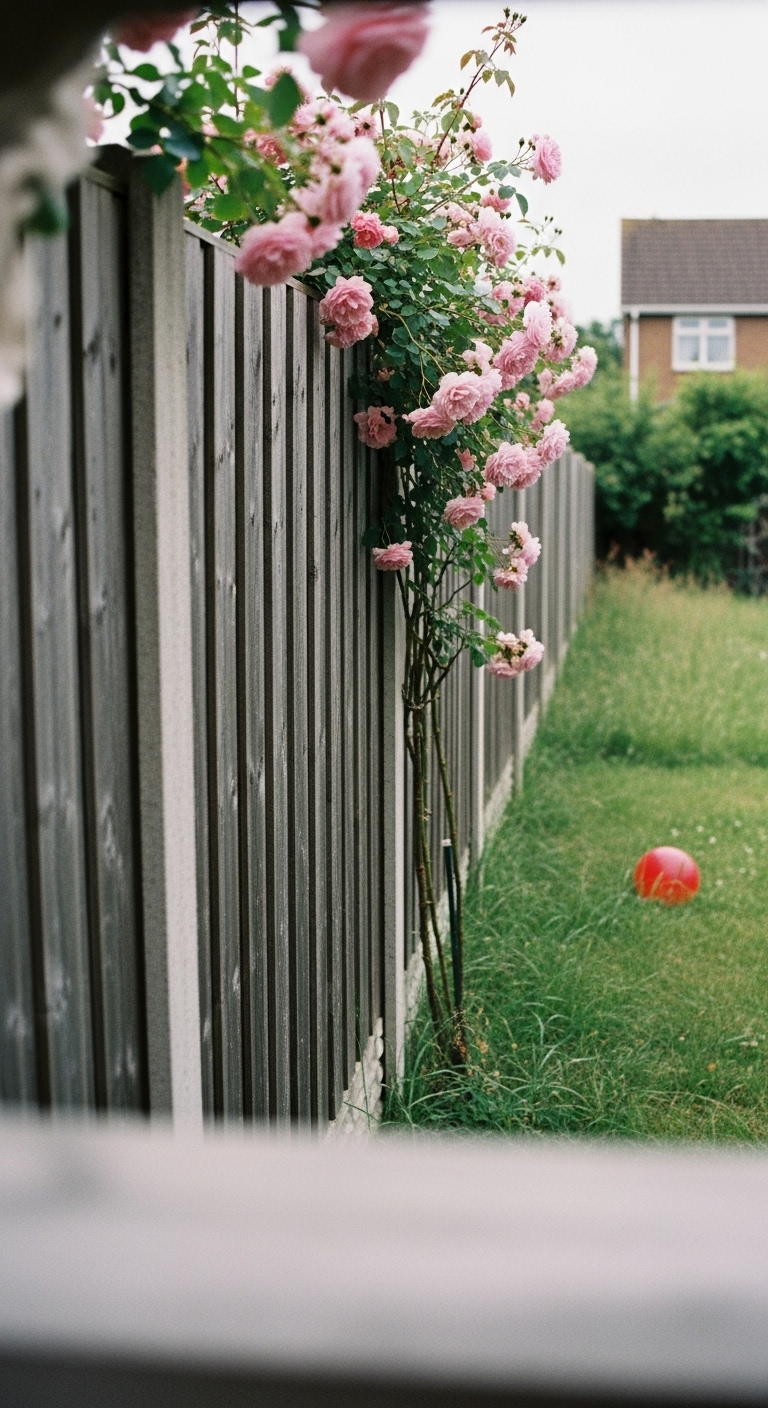
10. Climbing Rose Room Divider in Gardens
Use roses to define your outdoor space. A climbing rose on a freestanding trellis can act as a beautiful room divider. It can separate a dining patio from a play area. Or it can screen your vegetable patch from view. It is a functional design element that adds structure and beauty without building a solid wall.
For this to work, the support structure must be very stable. Use a wide-based trellis or set posts in concrete. You can use multiple trellis panels to create a longer screen. Plant a dense, bushy climber on each side for the best coverage. The reliable ‘Climbing Iceberg’ is a fantastic selection because its profuse white blooms create a solid-looking screen.
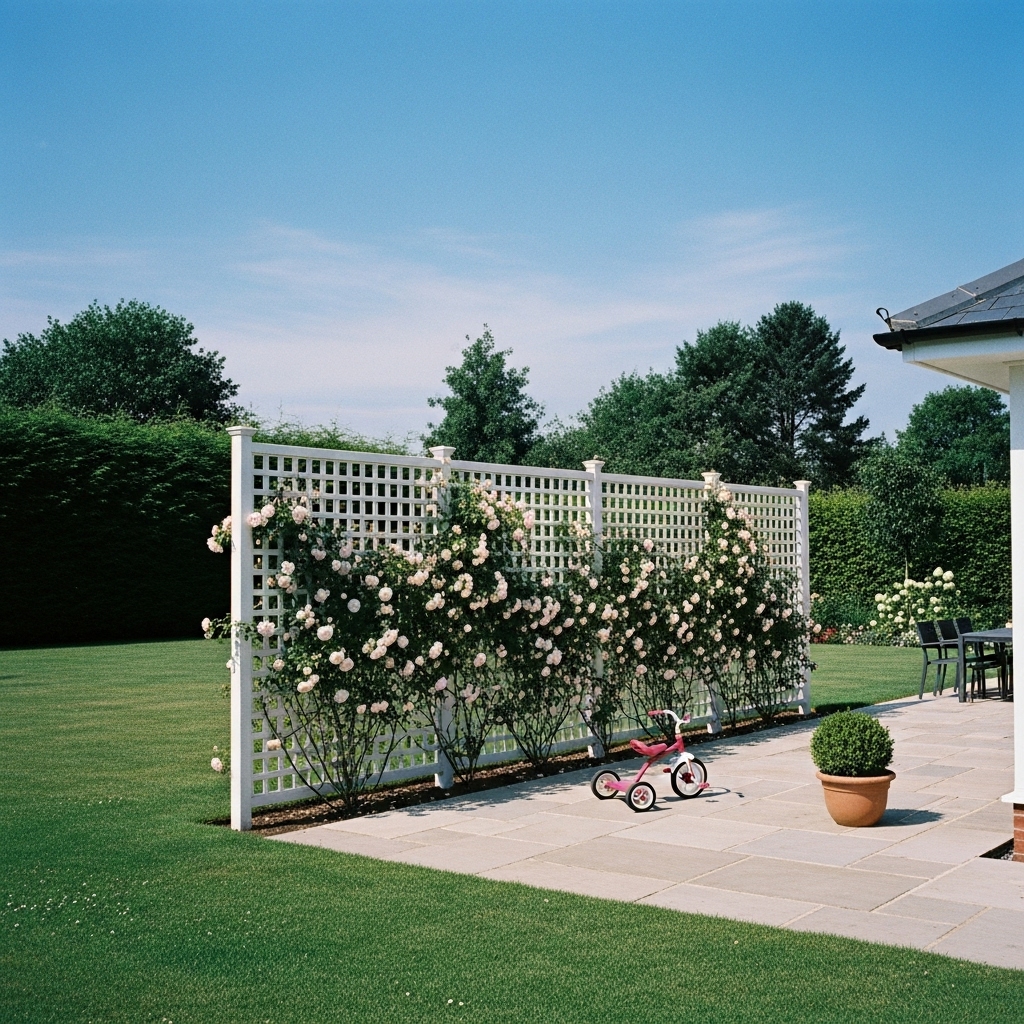
Timing and Planting Guide
Proper planting is the foundation for a healthy, beautiful climbing rose. Getting it right from the start saves you headaches later. It ensures your rose gets established quickly. A happy rose will reward you with strong growth and lots of flowers for years to come. Think of it as setting your new plant up for success.
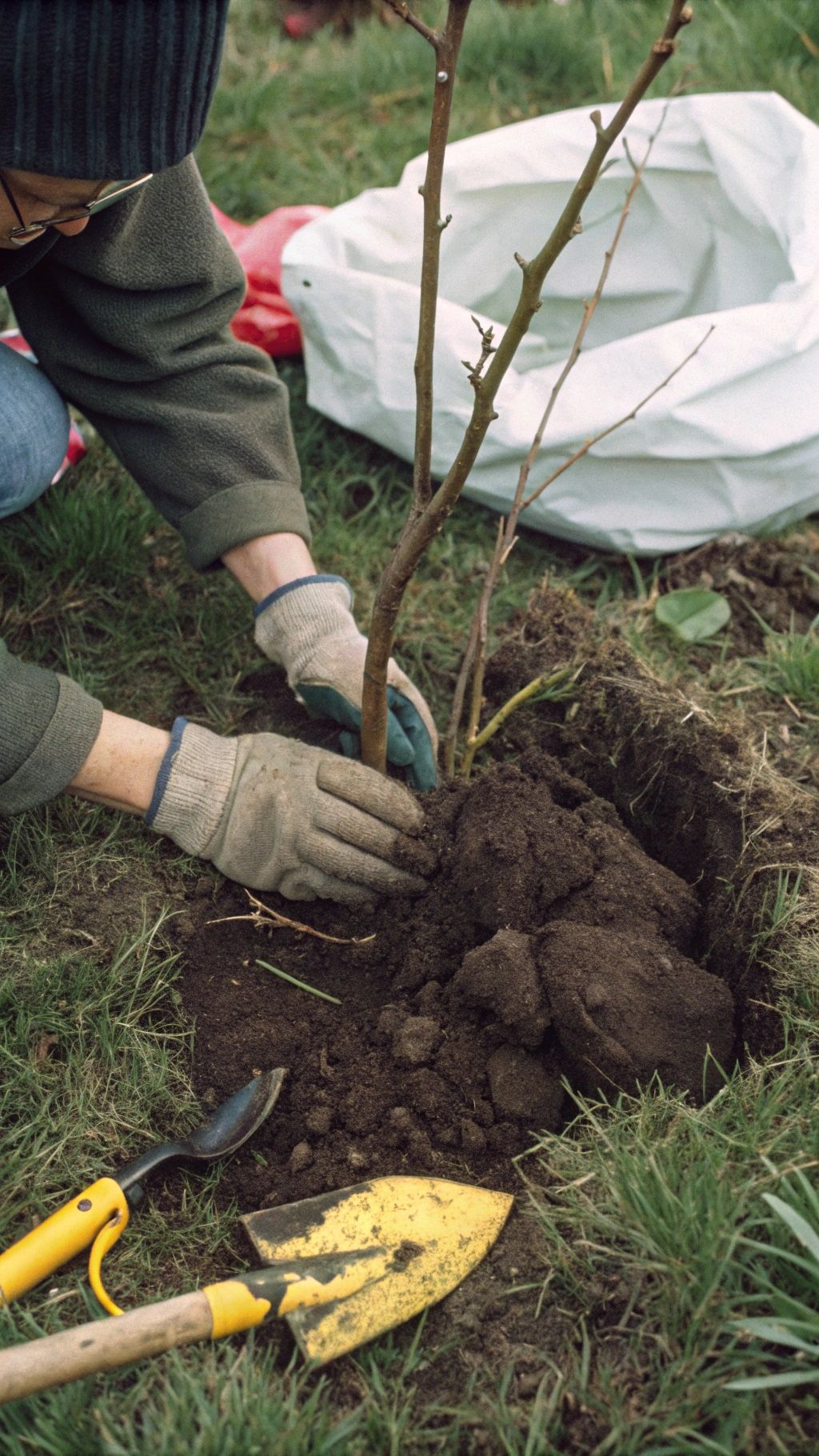
When to Plant
Timing depends on how you buy your rose. Roses are sold in two main forms. Bare-root roses are dormant plants. They look like a bundle of sticks with roots. They should be planted in late winter or early spring while the ground is workable but before they start to grow.
Container-grown roses are plants that are already growing in a pot. You can plant these almost anytime during the growing season. But spring and fall are the best times. Planting in the intense heat of summer can stress the plant.
Planting for Success
First, pick a spot that gets at least six hours of direct sunlight per day. Dig a hole that is twice as wide and just as deep as the plant’s root ball. Mix some compost or other organic matter into the soil you removed. Place the rose in the hole, ensuring the bud union (the swollen part where the rose was grafted) is at or slightly above ground level. Fill the hole back in, gently firming the soil. Water deeply.
Training and Care
Your job as a trainer begins right away. Don’t let the canes grow straight up. Encourage horizontal training. Tie the main canes so they are growing as close to horizontal as possible along your support structure. Angled canes send up more flowering shoots than vertical ones. Use soft ties that won’t cut into the stems.
Pruning is crucial for climbing roses. The main prune happens in late winter. Remove any dead, diseased, or crossing canes. Then, shorten the side shoots that bloomed last year, leaving just a few buds on each. Water regularly, especially during dry spells. Feed your rose with a balanced fertilizer in the spring to encourage a season full of spectacular blooms.
Color Schemes and Design Tips
Color is emotion. It sets the mood for your entire garden. The colors you choose for your roses can make a space feel calm, energetic, or romantic. Think about the feeling you want to create. Do you want a peaceful corner for reading? Or a vibrant backdrop for outdoor parties? Your rose selection is a powerful design tool.
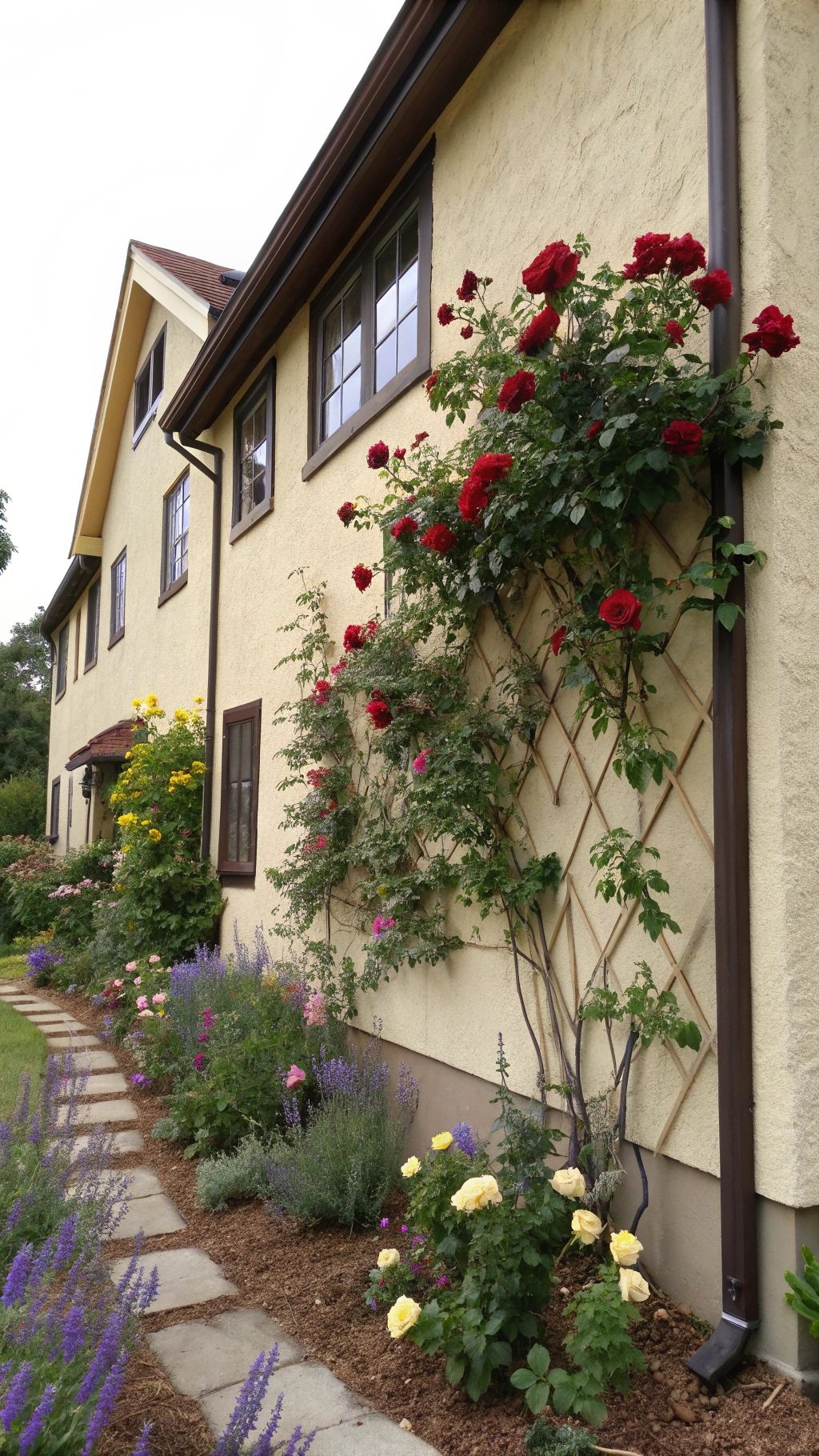
Classic and Romantic Palettes
The timeless garden look often uses a soft color palette. Think of gentle pinks, dreamy creams, and pure whites. These colors create a feeling of peace and romance. They glow beautifully in the morning and evening light. A combination of ‘New Dawn’ (pale pink) and ‘Climbing Iceberg’ (white) is a perfect example. They can be woven together on an arch or pergola for a breathtaking effect. This scheme works well against almost any background, from dark brick to light siding.
Vibrant and Energetic Hues
Want your garden to pop with energy? Go for bold and bright colors. Strong reds, sunny yellows, and fiery oranges create excitement. They draw the eye and make a powerful statement. A fiery red rose like ‘Blaze Improved’ against a white fence is impossible to miss. A golden yellow like ‘Graham Thomas’ can brighten up a dreary corner. Be careful not to overwhelm a small space. But for a feature you want to show off, vibrant hues are a fantastic choice.
Cool, Calm, and Collected
For a truly serene garden retreat, stick to a cool color scheme. White is the star of this look. It feels clean, calm, and sophisticated. Pair a white rose like ‘Climbing Iceberg’ with companion plants that have blue or purple flowers, such as lavender or salvia. The cool tones are restful to the eye. This minimalist approach is very effective in modern garden designs. It creates a space that feels uncluttered and peaceful.
Achieving the Ideal Aesthetic
Bringing your vision to life requires a few practical tools and techniques. The right support structure is as important as the rose itself. It is the skeleton that your beautiful creation will grow on. And a little bit of planning goes a long way. Understanding the balance between the plant’s natural tendencies and your design goals is the secret to a stunning result.
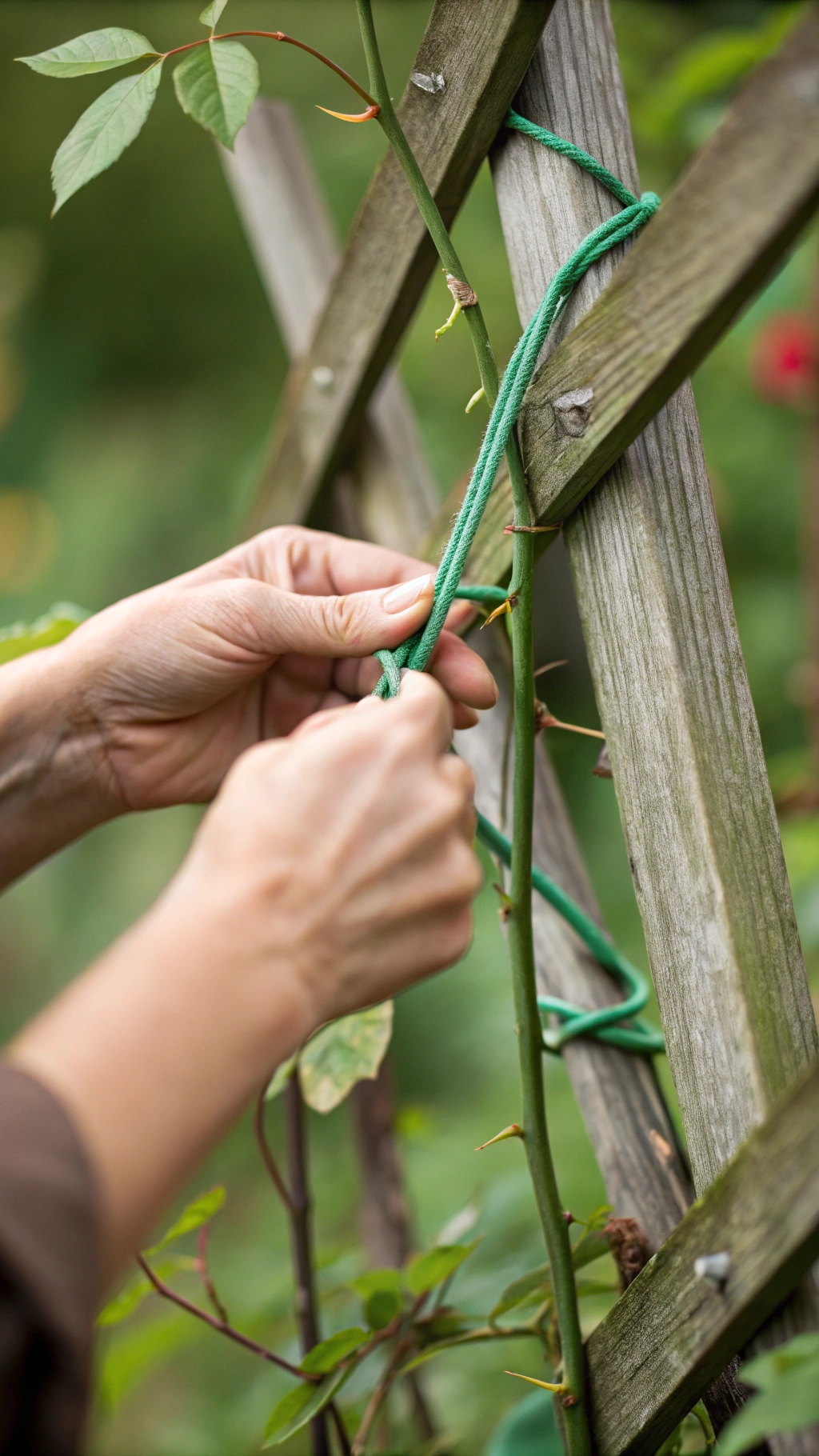
The Right Materials and Structures
Your support structure needs to match both your garden’s style and the rose’s eventual size. Rustic wooden trellises and pergolas are perfect for cottage gardens. Sleek metal obelisks or simple wire systems look great in modern spaces. Whatever you choose, make sure it is strong. A fully grown climbing rose covered in wet blooms is very heavy. Anchor it securely to walls or set posts deep into the ground.
A Beautiful Balancing Act
The most beautiful climbing roses are a result of a partnership. You provide the structure and guidance. The rose provides the wild, natural beauty. Don’t try to force it into a perfectly rigid shape. Allow for some natural arching and weaving. The goal is structured design, not a plant in a straitjacket. Your regular pruning and training will keep it healthy and within bounds. But the final look should feel graceful, not stiff.
Common Pitfalls to Avoid
A few common mistakes can lead to a sad-looking rose. First, don’t plant too close to a wall or fence. Roses need good air circulation to prevent fungal diseases like black spot. Leave at least a foot of space. Second, avoid using thin string or wire to tie up canes. It can cut into the stems as they grow and thicken. Use soft, stretchy garden ties. Finally, don’t underestimate the size of a mature rose. A small, cute plant from the nursery can become a giant. Choose a variety that is the right size for your chosen spot.
A Garden Transformed
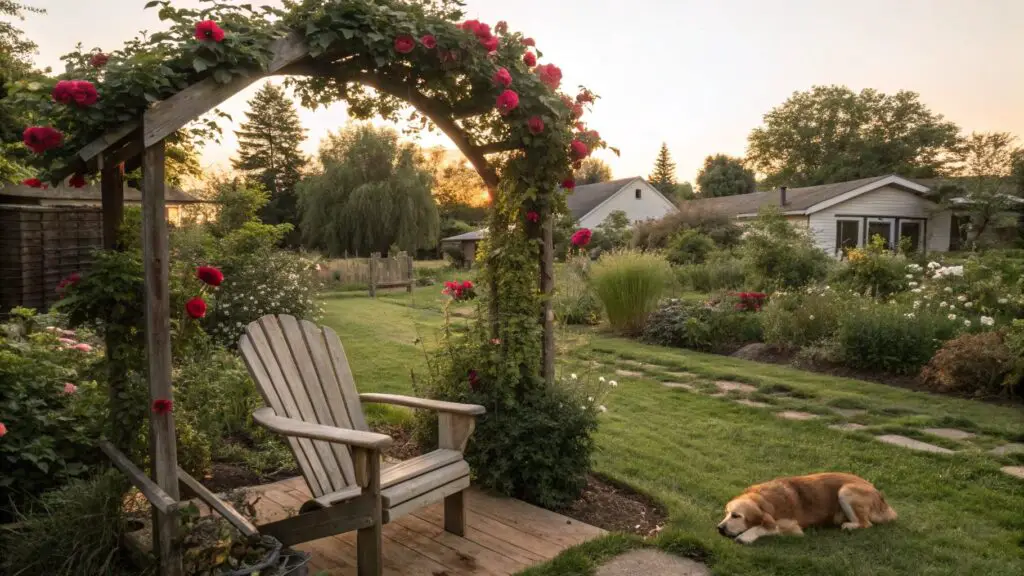
Climbing roses are more than just flowers. They are agents of transformation. They can breathe life into dull walls and soften hard edges. They can turn a simple structure into a work of art. The ideas we’ve explored are just starting points. The real joy comes from making them your own. Don’t be afraid to experiment. Mix and match varieties. Create your own unique color schemes.
Your garden is a personal expression. Let a climbing rose be one of your boldest statements. The time you spend planting, training, and caring for it will be returned to you a hundred times over. It will be returned in fragrant summer evenings on the patio. It will be returned in the simple pleasure of seeing a beautiful flower frame your window. You are not just planting a rose. You are cultivating years of beauty and creating a living legacy.
